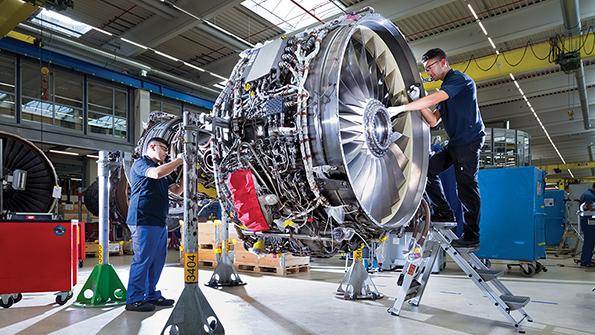
The CFM56 and V2500 families will account for around one-third of commercial engine aftermarket spending in 2020, with MRO demand boosted as mature models are kept in service longer owing to the slower pace of their successors entering service.
This slowdown is the result of technical issues related to CFM International’s Leap, the CFM56’s successor, and the Pratt & Whitney PW1000G geared turbofan (GTF) over the past few years. In a commercial engine segment valued at $34.7 billion for the year by Aviation Week’s latest Fleet & MRO Forecast, the CFM56 and V2500 are forecast to generate $12.9 billion in combined spending over a 12-month period.
The CFM56 family is projected to have approximately 23,058 units in service this year, with the -7B variant powering the Boeing 737NG the most prominent, accounting for more than half of the CFM56 fleet. Meanwhile, the V2500 engine found on the Airbus A320 aircraft family will have 6,000 units in service.
- Engine segment’s aftermarket Share stands at 42%
- North America will see Highest engine MRO spending in 2020
While the surplus of work will be good news for repair specialists, the longevity of the CFM56 and V2500 also could ensure that MRO market capacity will remain tight for the next 2-3 years at least. The availability of spare engines and related materials likely also will be scarce for the next few years, until relief comes in the form of retirements hitting the market and supplying more used materials.
These retirements are expected to pick up starting in 2023 for CFM56 engines, when for the first time more than 1,000 will be retired during that year. By the end of the decade in 2029, an estimated 8,858 CFM56 engines will leave service. Retirements of the V2500 also will increase gradually. Numbering just 98 in 2020, over a 10-year period approximately 2,178 V2500s will be phased out.
While the arrival of the new narrowbody engines has been sluggish, the influx of the Leap and GTF is nevertheless still expected to pick up. According to Aviation Week data, around 2,600 deliveries of the Leap are expected in 2020. However, this figure could be dependent on the fortunes of the -1B variant, the engine option for the Boeing 737 MAX program.
In 2019, the aircraft was dogged by problems unrelated to its Leap engines, leading to the grounding of the fleet in March. Boeing said it intends to have the aircraft back in service during 2020, but the groundings have hit some OEMs hard.
While some airlines have since placed large orders for the MAX (such as British Airways’ for 200 aircraft), others have chosen to look elsewhere. These include low-cost carrier Flyadeal of Saudi Arabia, which canceled its order for up to 50 of the Leap-powered aircraft in summer 2019. The Leap 1A variant for the A320neo, which entered service in 2015, will not see any significant MRO spending until 2024.
Aviation Week predicts the widebody engine segment will account for $16.5 billion of the market in 2020. The segment, dominated by GE Aviation and Rolls-Royce, which hold 50% and 33% shares of the market, respectively, will account for an estimated 2,257 maintenance events throughout the year. Of GE Aviation’s market share, 30% will emanate from the CF6-80C2, used on several Boeing and Airbus widebody aircraft including the A330, 747 and 767.
Powering the 787, a popular aircraft option for airlines looking to reduce fuel consumption costs, GE Aviation’s GEnx engine will see the highest delivery volumes, with 248 engines set for 2020. This will be followed by Rolls-Royce’s Trent XWB, the exclusive option for the A350, which will see 240 deliveries in 2020, according to Aviation Week data. GE’s CF6-80 model, powering aircraft including the A330, 757 and 767, will have the highest volume of retirements over 10 years, numbering 1,649 units in 2020-29.
In the turboprop segment, which accounts for just 5% of the global commercial fleet, aftermarket spending is centered on just a handful of engine types. Pratt & Whitney Canada will hold more than 80% of the market in 2020, with much of this related to the PW100 engine, primarily found on the ATR42 and 72. With no new entrants expected in the turboprop segment, the OEM’s market dominance will grow over the next decade—standing at around 92% by 2029.

